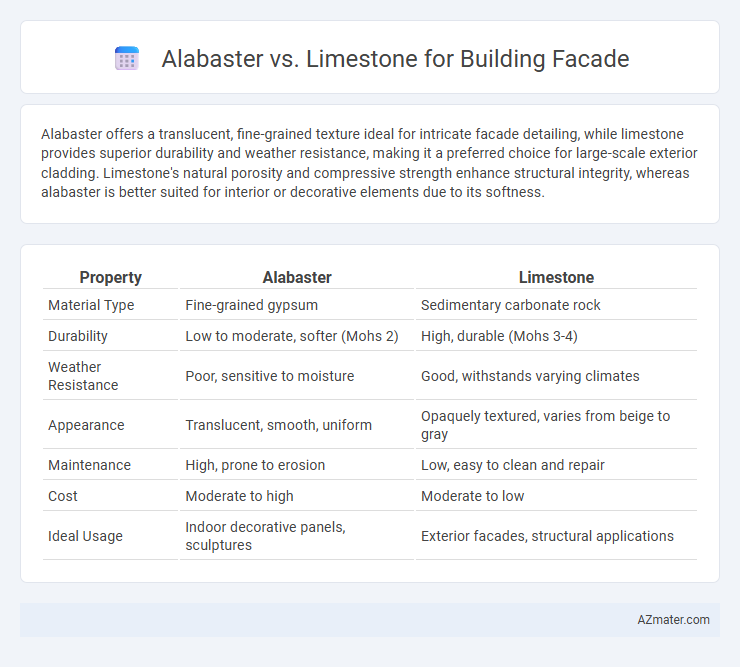Alabaster offers a translucent, fine-grained texture ideal for intricate facade detailing, while limestone provides superior durability and weather resistance, making it a preferred choice for large-scale exterior cladding. Limestone's natural porosity and compressive strength enhance structural integrity, whereas alabaster is better suited for interior or decorative elements due to its softness.
Table of Comparison
| Property | Alabaster | Limestone |
|---|---|---|
| Material Type | Fine-grained gypsum | Sedimentary carbonate rock |
| Durability | Low to moderate, softer (Mohs 2) | High, durable (Mohs 3-4) |
| Weather Resistance | Poor, sensitive to moisture | Good, withstands varying climates |
| Appearance | Translucent, smooth, uniform | Opaquely textured, varies from beige to gray |
| Maintenance | High, prone to erosion | Low, easy to clean and repair |
| Cost | Moderate to high | Moderate to low |
| Ideal Usage | Indoor decorative panels, sculptures | Exterior facades, structural applications |
Introduction: Alabaster vs Limestone for Building Façades
Alabaster and limestone are both popular materials used in building facades, each offering distinct aesthetic and structural properties. Alabaster is prized for its translucent quality and smooth, fine-grained texture, making it ideal for decorative and intricate facade designs. Limestone, known for its durability and wide range of colors, provides robust weather resistance suitable for exterior cladding in various architectural styles.
Geological Origins and Formation
Alabaster, a fine-grained form of gypsum, originates from the evaporation of ancient seas, resulting in a soft, translucent stone ideal for intricate carving in building facades. Limestone forms primarily from accumulated marine organisms' skeletal fragments, creating a denser, sedimentary rock used widely for durable and weather-resistant exterior surfaces. The geological differences impact their porosity, hardness, and longevity, influencing their suitability for various architectural facade applications.
Physical Characteristics and Appearance
Alabaster features a soft, translucent texture with a smooth, polished surface ideal for decorative facade elements, while limestone exhibits a more granular, porous structure with natural variations and durability suitable for exterior cladding. Alabaster's light-reflective quality enhances building aesthetics through subtle glow effects, contrasting with limestone's matte finish and earthy tones that offer timeless elegance and weather resistance. Both stones differ significantly in hardness, with limestone providing greater strength for structural purposes compared to alabaster's delicate, softer composition.
Durability and Weather Resistance
Alabaster is a softer, more porous material compared to limestone, making it less durable and more susceptible to weathering and erosion in exposed building facades. Limestone offers superior weather resistance with higher compressive strength and better ability to withstand freeze-thaw cycles, making it a preferred choice for exterior cladding. The natural hardness and low porosity of limestone enhance its longevity and reduce maintenance requirements in harsh environmental conditions.
Workability and Ease of Installation
Alabaster offers superior workability for building facades due to its fine grain and softness, allowing for precise carving and intricate detailing with less effort compared to limestone. Limestone, while harder and more durable, requires specialized tools and more labor-intensive techniques for cutting and shaping, which can extend installation times. The ease of installation for alabaster is enhanced by its lighter weight, reducing handling challenges and allowing faster assembly on-site.
Cost Comparison and Availability
Alabaster typically commands a higher price than limestone due to its rarity and delicate nature, making it less cost-effective for large-scale building facades. Limestone is widely available in numerous regions, offering a more economical option with extensive supply chains that lower transportation and procurement costs. The broad accessibility and affordability of limestone make it a preferred choice for budget-conscious construction projects when compared to the limited availability and premium cost of alabaster.
Maintenance Requirements and Longevity
Alabaster, a softer and more porous stone, requires more frequent sealing and gentle cleaning to prevent weathering and surface erosion on building facades, limiting its long-term durability. Limestone offers higher resistance to environmental wear and lower maintenance due to its denser composition, making it more suitable for exterior applications exposed to harsh weather. Properly maintained limestone facades can last several decades with minimal intervention, while alabaster surfaces often need stricter care to preserve their appearance and structural integrity over time.
Aesthetic Appeal and Design Versatility
Alabaster offers a translucent, smooth surface that enhances a building facade with a soft, luminous glow, making it ideal for designs seeking elegance and subtle light diffusion. Limestone provides a robust yet versatile texture with a wide color palette ranging from creamy whites to earthy tones, enabling architects to create both traditional and contemporary aesthetics. The choice between alabaster and limestone hinges on desired visual depth and design flexibility, with alabaster emphasizing refinement and limestone delivering structural character.
Environmental Impact and Sustainability
Alabaster, a gypsum-based stone, has a lower environmental impact than limestone due to its softer extraction process and reduced energy consumption during quarrying. Limestone, composed primarily of calcium carbonate, is more durable but often involves intensive mining and carbon emissions, raising sustainability concerns. Selecting alabaster for building facades promotes eco-friendly construction with minimal ecological disruption, while limestone's longevity contributes to long-term sustainability despite its higher initial environmental cost.
Choosing the Right Stone for Your Building Façade
Alabaster offers a smooth, translucent appearance ideal for decorative interior facades but lacks the durability required for exterior use, making limestone a superior choice for building exteriors due to its strength and weather resistance. Limestone provides excellent thermal insulation and can withstand environmental stress, ensuring longevity and minimal maintenance for facades exposed to harsh weather conditions. When selecting between alabaster and limestone for a building facade, prioritize limestone for exterior durability and structural support while reserving alabaster for ornamental, non-structural interior applications.

Infographic: Alabaster vs Limestone for Building Façade
 azmater.com
azmater.com